
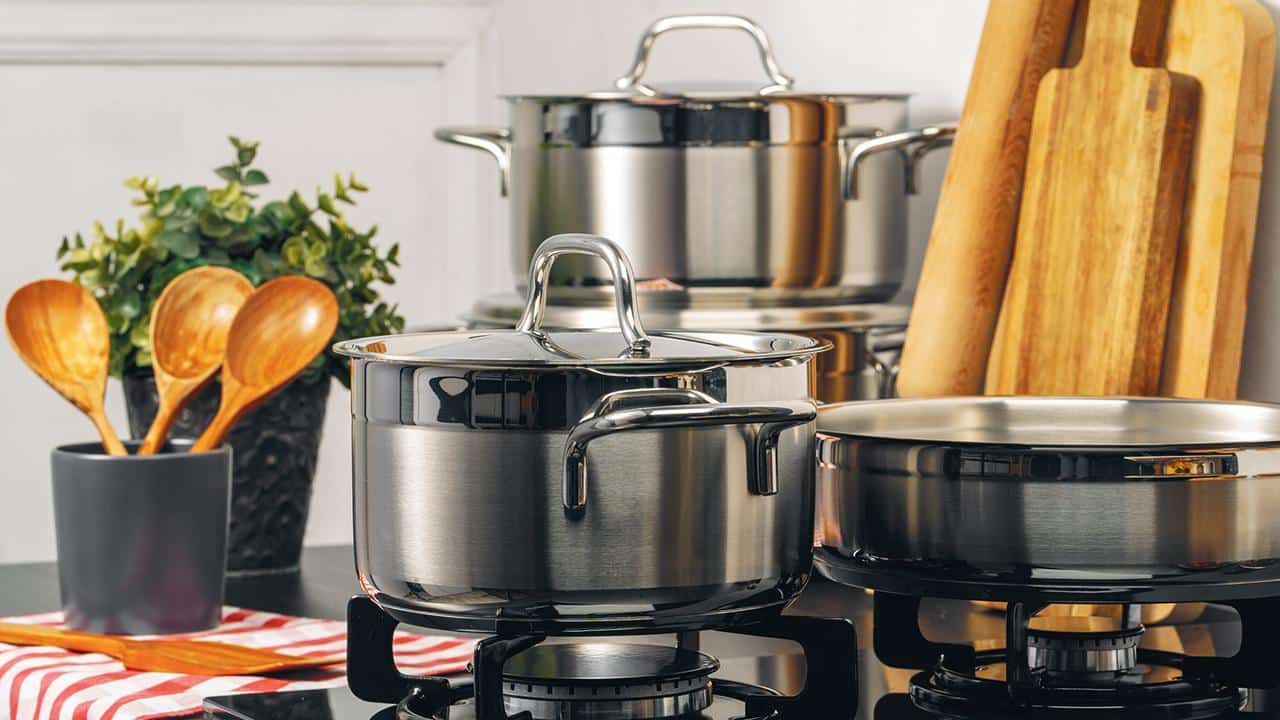
FabrikaCr / iStock / Getty Images
While Teflon has been used extensively in traditional pots and pans since the 1940s, studies have shown that switching to a non-toxic option is much better for your health and the health of the planet. But with so many options available, it can be hard to narrow down the best non-toxic cookware sets.
In this article, we’ll discuss eight cookware options that use materials ranging from stainless steel to granite to cast iron. We’ll also give recommendations for budget-friendly and multi-purpose pots and pans so you can choose the best set for your eco-friendly kitchen.
Best Non-Toxic Cookware Sets
Each product featured here has been independently selected by the writer. Learn more about our review methodology here. If you make a purchase using the links included, we may earn a commission.
- Best Overall: GreenPan Lima Healthy Ceramic Nonstick Cookware Set
- Best Budget-Friendly Cookware: GreenLife Ceramic Nonstick Cookware Set
- Best Stainless-Steel Option: HomiChef Nickel-Free Stainless-Steel Cookware
- Best Granite Option: Michelangelo Stone Cookware
- Best Cast Iron Option: Le Creuset Enameled Cast Iron
- Best Bakeware: Caraway Bakeware Set
- Best Multi-Purpose Pan: Always Pan
- Best for Easy Storage: Caraway Cookware Set
Why Switch to Eco-Friendly Cookware?
When it comes to eating our favorite meals, it isn’t often we consider the toxicity of the cookware we use to make them.
Teflon is a brand name for the synthetic chemical polytetrafluoroethylene (PTFE), which is in the family of chemicals known as per- and polyfluoroalkyl substances, or PFAS. According to the Environmental Working Group, “PFAS chemicals pollute water, do not break down and remain in the environment and people for decades. Some scientists call them ‘forever chemicals.'”
Chemicals such as PFAS and PTFE are common in nonstick cookware and can transfer into the food we eat. It was only found recently by the FDA that these synthetic polymers actually put our health at risk, as they have a long half-life, don’t metabolize and bio-accumulate, leading to health problems. When Teflon cookware is heated above 300 degrees Fahrenheit, it can produce toxic fumes; if inhaled, these can lead to polymer fume fever, better known as “Teflon flu.” Some studies have also shown a link between PFAS and certain cancers.
PFAS and PTFE also don’t break down in the environment, making it possible for the polymers to re-enter our bodies and the ecosystems around us.
Instead of purchasing cookware that uses a synthetic chemical like Teflon, other materials such as stainless steel, granite and ceramic can be much safer options. Pots and pans made of natural stone or metals are considered the safest cookware to purchase, as they usually don’t contain harmful chemicals.
Full Reviews of Our Top Picks
When choosing our top recommended eco-friendly cookware sets, we looked at factors including:
- Materials: Even though a product may be ceramic or stone, it still can have coatings containing PFAS chemicals. We verified that each cookware option on our list is made without harmful synthetics.
- Durability: When investing in suitable cookware, it’s important that what you buy will hold up with the wear and tear of daily cooking.
- Customer reviews: As always, we consider what real, long-term customers have to say about products’ wear, efficacy and overall satisfaction.
Best Overall: GreenPan Lima Healthy Ceramic Nonstick Cookware Set

www.greenpan.us
Designed with people’s health and the environment in mind, GreenPan cookware is free of PFAS, PFOA, lead and cadmium. Instead, it is made from anodized aluminum with a ceramic, naturally nonstick coating and is finished with stainless-steel handles. These materials are metal-utensil safe, durable, scratch-resistant and oven/broiler safe up to 600 degrees F (with glass lids safe up to 425 F), making the cookware perfect for daily use.
The GreenPan 12-piece set contains everything you would need in your kitchen to cook a great meal, including two frypans, two saucepans, four tempered-glass lids and a casserole dish. It also comes with a steamer for your veggies and three soft bamboo utensils to help keep your cookware free from scratches. The cookware works on almost every stovetop (except induction stoves), and the materials evenly conduct heat throughout the pan.
Customer Rating: 4.5 out of 5 stars with about 1,000 Amazon ratings
Why Buy: Amazon’s Choice for ceramic cookware, this GreenPan eco-friendly cookware set is free of PFAS, PFOA, lead and cadmium. Even if accidentally overheated, the GreenPan won’t produce any toxic fumes.
Best Budget-Friendly Cookware: GreenLife Ceramic Nonstick Cookware Set
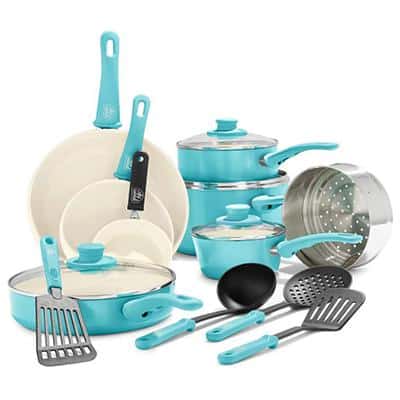
www.greenlife-cookware.com
GreenLife’s nonstick ceramic cookware is popular among customers for its high quality and low price. The inner core is made from recycled aluminum and with a ceramic coating derived from sand. The nonstick pots and pans come in seven colors to choose from and include colorful, soft handles that stay cool while your food cooks.
In the cookware set, you receive three sizes of frying pans, two saucepans, a stockpot, a saute pan and four kitchen utensils. Oven safe up to 350 degrees F, this cookware is free of PFAS, PFOA, lead and cadmium. The products work great on all stovetops, but be extra careful with gas stove stops, considering the silicone handle. The set is also dishwasher safe.
Customer Rating: 4.5 out of 5 stars with over 9,000 Amazon ratings
Why Buy: The GreenLife ceramic cookware set gives you the best bang for your buck, with a total of 16 quality and non-toxic cookware products at an affordable price.
Best Stainless-Steel Option: HomiChef Nickel-Free Stainless-Steel Cookware
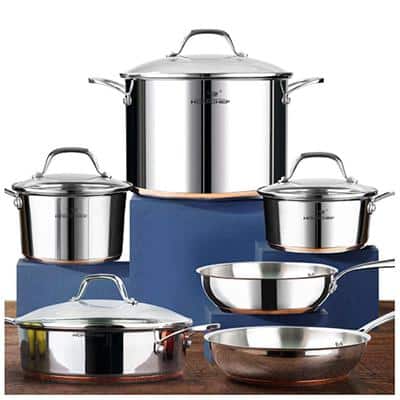
www.homichef.com
If you’re looking for a coating-free option, consider HomiChef’s stainless-steel cookware. Each piece in the cookware set contains an aluminum core between two layers of stainless steel and is finished with elegant copper bands. The 10-piece set includes three different-sized saucepans, two frying pans, four glass lids and a 7-quart stockpot.
While you may need to add a little extra oil to keep food from sticking, the shiny, sleek utensils don’t contain any coatings, which eliminates the risk of toxic chemicals entering your food. Nickel, a known carcinogen that can leach into food when overheated, is a concern with many stainless-steel products. This cookware is completely free of nickel, making it safer, more energy-efficient and more corrosion-resistant than regular stainless-steel cookware.
Customer Rating: 4.4 out of 5 stars with over 1,000 Amazon ratings
Why Buy: Amazon’s Choice for stainless-steel cookware as well as nickel-free cookware, the HomiChef set has a six-year warranty, and buyers who have made returns or asked questions have reported satisfaction with the company’s customer service.
Best Granite Option: Michelangelo Stone Cookware
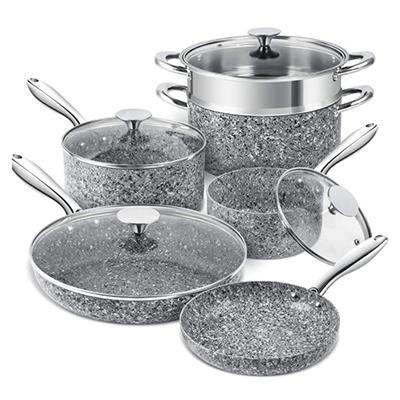
michelangelokitchen.com
Founded in Haan, Germany, in 1931, Michelangelo Kitchenware has been making high-quality and beautiful cookware sets for nearly a century. Included in the PFOA-free granite cookware set are two frying pans, two saucepans and a large stockpot perfect for family-sized meals. The long, angled handles make the cookware comfortable to grip and easy to pour from, even when heavy.
The pots and pans in this 10-piece set have a spiral bottom for quick and even heat transfer. They work well on all except induction stovetops and are oven-safe up to 450 degrees F. The stone cookware contains a non-toxic die-cast aluminum body with a stone-derived nonstick coating. Although it is easy to clean by hand, the set is dishwasher safe and scratch-resistant. The granite interior and exterior provide extra durability and wear-resistance while also looking great on any stovetop.
Customer Rating: 4.5 out of 5 stars with over 1,400 Amazon ratings
Why Buy: Nonstick coating and scratch-resistant, this tough and non-toxic cookware set is said by customers to be slightly larger than normal cookware, which makes it perfect for bigger meals.
Best Cast Iron Option: Le Creuset Enameled Cast Iron Dutch Oven
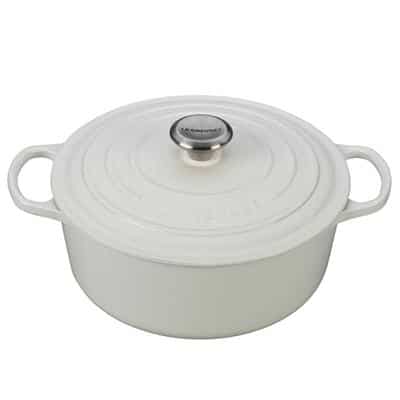
www.lecreuset.com
The world-renowned Le Creuset Enameled Cast Iron Dutch Oven is a kitchen staple that can be passed down from generation to generation. Its porcelain enameled coating is smooth, scratch- and wear-resistant and prevents the pot’s iron core from leaching into food. The dutch oven is superb at retaining heat and moisture with its thick dome structure and lid.
Le Cruset’s products are compatible with all stovetops and ovens, including wood-burning and coal-powered appliances. They are also dishwasher-safe. Whether you choose to slow-cook a casserole or bake a cake, Le Creuset’s cast iron pots and pans come in a range of shapes, sizes and colors to meet all of your cooking and baking needs.
Customer Rating: 4.8 out of 5 stars with over 1,200 Amazon ratings
Why Buy: Le Creuset products have been recognized for their lifelong durability since 1925. The company’s simple yet strong designs are PTFE/PFOA free, and their versatility is perfect for all your one-pot meals.
Best Bakeware: Caraway Bakeware Set

www.carawayhome.com
Compared to traditional nonstick coatings, Caraway’s bakeware is completely non-toxic and produces 60% fewer carbon emissions during manufacturing. The brand’s Complete Bakeware Set includes two baking sheets, a cooling rack, five different sized pans, a muffin pan and a convenient storage rack.
The aluminum body of each product is coated with a nonstick ceramic layer and has stainless-steel handles. Oven safe up to 550 degrees F, these colorful essentials provide even heat distribution and are easy to clean after baking your favorite treats. Once you unpack your new kitchen utensils, you can easily recycle their cardboard packaging.
Customer Rating: Reviews on Caraway’s site give the brand 4.9 out of 5 stars with over 20,000 ratings across all products.
Why Buy: Free of all PFAS, including PFOA and PTFE, these sustainable oven pans and sheets will take care of all your baking needs while keeping you healthy.
Best Multi-Purpose Pan: Always Pan
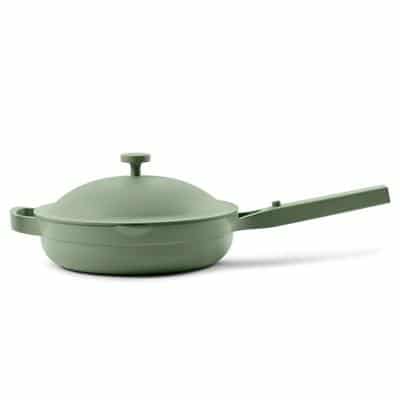
fromourplace.com
This non-toxic pan from Our Place has made waves with its innovative design, which is intended to replace up to eight traditional pieces of cookware. The Always Pan can fry, boil, steam, strain, serve and store your everyday meals. Its nonstick ceramic coating is free of PFAS, lead, cadmium, toxic metals and nanoparticles.
The high-quality pan works on all stovetops — including induction stoves — and will reduce clutter in your cabinets while increasing the available storage space in your kitchen. It includes a lid that can either vent or contain moisture, a beechwood spoon designed to rest on the stay-cool silicone handle and a perfectly fitting steamer basket.
Customer Rating: 4.6 out of 5 stars with over 19,000 ratings on the Our Place site
Why Buy: This pan has a high heat retention and can be used on any type of stovetop or burner. It is free of heavy metals and has versatile uses to cook any range of meal types.
Best For Easy Storage: Caraway Cookware Set
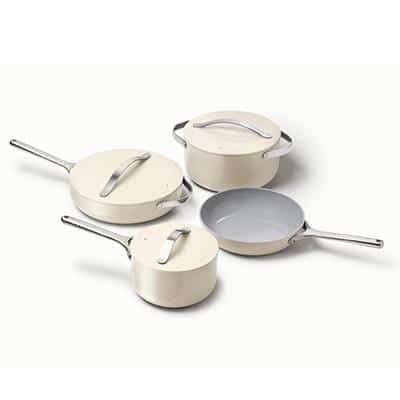
www.carawayhome.com
The sleek design of Caraway’s cookware set is perfect for tight kitchens. The cooking set includes a storage center for pots and pans as well as lid holders that can be placed on cabinet doors. Much like Caraway’s other products, this cookware is composed of an aluminum core with a nonstick ceramic coating and stainless-steel handles.
You can choose from a range of colors to match your kitchen decor, from cream to sage to marigold. The ceramic nonstick cookware requires less oil or butter for your meals to be cooked to perfection. When you’re finished with your pots and pans, simply let them cool and then lightly scrub for an unblemished clean.
Customer Rating: Reviews on Caraway’s site give the brand 4.9 out of 5 stars with over 20,000 ratings across all products.
Why Buy: Free of PTFE and other toxic chemicals, the Caraway cookware set includes storage racks for pots, pans and lids to provide you with a wide variety of cooking options while taking up minimal space.
Choosing the Best Non-Toxic Cookware Set for Your Kitchen
It’s important to pick a cookware set that’s free of PFAS and other toxic chemicals, but how do you narrow down the best option for your cooking and baking needs? Consider the benefits of each cookware material:
Ceramic-coated cookware is a safe alternative to Teflon, especially if you’re looking for smooth nonstick pots and pans. Ceramic is considered a great heat conductor, helping your food cook evenly, and the slick surface makes for an easy clean. Ceramic cooking surfaces are best for preparing more delicate meals like eggs, tofu and fish. This type of cookware typically comes in a range of colors that are mixed into the layer of material just under their final coat of ceramic glaze.
Granite cookware actually doesn’t contain pure stone, so it’s much lighter than cast iron cookware. These pots and pans have an inner core made typically of aluminum or carbon steel that’s finished with porcelain or stone-derived enamel. The nonstick coating doesn’t leach when heating highly acidic foods, so it’s great for cooking with tomatoes, vinegar, citrus and alcohol. Plus, specks of black and grey in the nonstick enamel leave an attractive appearance that makes for a unique feature in any kitchen.
Stainless-steel cookware is best for sauteing, boiling, browning or deep frying. These pots and pans are usually composed of an aluminum core with stainless-steel walls. The bright and shiny look can give a kitchen a more professional appearance. This material has a non-porous surface, which makes it easy for cleaning. However, it is not a naturally nonstick surface, so you may need to use oil or an alternative fat to prevent sticking. Even if burn spots happen, soaking your cookware in common household items such as baking soda and vinegar will bring back the shiny surface.
Frequently Asked Questions: Eco-Friendly Cookware
What is the safest cookware for your health?
Ceramic cookware is considered safer than Teflon cookware because it is free of harmful chemicals such as PFAS (per- and polyfluoroalkyl substances such as polytetrafluoroethylene) and PFOA (perfluorooctanoic acid). It can be safely heated to higher temperatures than traditional Teflon pots and pans while still maintaining a nonstick surface.
What brand of cookware is non-toxic?
Many non-toxic cookware brands such as GreenLife, Le Creuset and Caraway have safe kitchen products that won’t seep toxins into your food. Ceramic and other stone-derived products are naturally nonstick and are great heat conductors, so these eco-friendly choices never need harmful synthetic additives such as PFAS.
Is ceramic cookware eco-friendly?
Removing as little as one to two steps while constructing cookware can lead to producing fewer carbon emissions. Ceramic cookware only takes one layer of coating to be nonstick, whereas Teflon usually takes around three coatings. Cutting down manufacturing leads to 50% less carbon dioxide emissions compared to the Teflon pans. Ceramic items also don’t contain toxic chemicals that risk leaching into the environment or into your food.

 233k
233k  41k
41k  Subscribe
Subscribe 